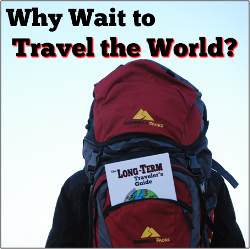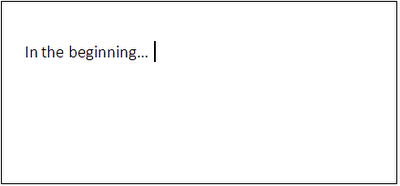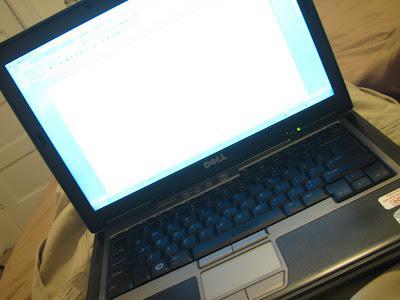 During our time putting together our first self-published travel book, The Long-Term Traveler's Guide, we had to spend a lot of energy into learning about the self-publishing process and the travel guidebook market in general. In order to save future author's time and money, this ten-part Writing a Travel Book series was born!
During our time putting together our first self-published travel book, The Long-Term Traveler's Guide, we had to spend a lot of energy into learning about the self-publishing process and the travel guidebook market in general. In order to save future author's time and money, this ten-part Writing a Travel Book series was born! The following is a quick list of the entries into this special feature. To learn more about our book launch and other information associated, please check out the Travel Book sidebar on this site.
Part 1 - Finding a Niche and Writing
Part 2 - Editing and Formatting
Part 3 - Evolution of a Cover Design
Part 4 - Digital Packages and Special Features
Part 5 - Developing a Website for Sales
Part 6 - Distribution Companies
Part 7 - Pricing Development and Launch
Part 8 - Affiliate Sales Programs and Tips to Succeed
Part 9 - The Cost of Writing and Sales Summary
Part 10 - Final Thoughts
Writing a Travel Book Part 1 - Finding a Niche and Writing
So you want to self-publish a travel book? Congratulations! Making the leap from independent writing to full-fledged authorship is a giant step and a lot of work. Luckily, writing a book for the travel audience like we did is, in our opinion, one of the more exciting topics to get out there. This series was developed based on our experiences in publishing a travel book, and some of the tips included will be tilted towards such. If you are looking to publish a book in another genre, don't worry! Many of the tips that are included in this series are universal regardless of the sector.
Find Your Niche

Writing a book, regardless of genre, starts with finding your niche. Much like writing a blog, publishing a book that already exists will not have as good of reception as something new and unique to the market. Do you write about an interesting story you experienced? Make up a fictional story with the destinations you've traveled as backdrop? Or go informational in the form of a guidebook? As exciting as my travels are to myself, they only make good blog posts and would not have a hook in book format.
I've had no life-changing experiences and purely go off to explore the world at my own pace, have some adventures that everyone else can have, and come back. My experiences make for good blog posts, but may be hard to populate a 250 page book. Other traveler's, such as Torre DeRoche, author of Swept, goes off and sails around the world with a guy she just met and turns into a life-altering experience. See the difference between the two? If your personal experiences do not have an edge, you may wish to write in another style.
For The Long-Term Traveler's Guide, I was quite astounded when I saw that there were thousands of guidebooks that existed for cities, but hardly any purely dedicated to how to travel, especially for the long-term market. There were a few, but glancing through chapter summaries, excerpts, and reviews said there was a gap needing to be filled. Since planning for long-term travel is a very intense process with many facets that could be easily overlooked, and I've been writing about it on this blog for years, the book was born.
Often, a quick Google search and browsing of books on the Amazon marketplace will get you enough information to see if your niche has been covered or not. If you think you've found something and want to run with it, begin writing!
Get to Writing

There are two common writing techniques that most authors fall into when writing a book: edit as you go or edit at the end. I decided to finish a complete draft of the guide prior to editing, as I felt that with my borderline OCD attention-to-detail it would take me too long to accomplish anything by stopping to edit after every chapter. But keeping it in perspective, there are merits to both options.
Write slow and edit as you go - Only a select group of authors are able to keep all of their thoughts straight while taking the time to write slowly and perform major edits as they go. Fiction and non-fiction books are much more suited for this writing style as they typically move in a chronological pace where the chapters in the future have little impact to the events that preceded it. In this instance there is no concern to doing major edits before moving on, and lower odds that something will pop up during later chapters that will cause you to delete it all and start over.
Even though this course of writing will put a substantial amount of time into the refinement stage while writing each chapter, there will still be a large undertaking at the end to ensure the book has a natural flow. It is with this reason that we are cautious in recommending the edit as you go process for aspiring authors who have not put out a book in the past. For all that fit in this category, speed writing may be for you.
Speed write and edit at the end - For all other books, especially those that are informational in nature, editing at the end may be a more effective use of your time. You may never know when a future chapter will make you want to delete entire sections preceding it, and with it goes the hours you spent doing focused edits. It is likely that your final book will be so unrecognizable to the first draft that it is best to keep this effort for a later date.
To begin your speed writing activities, make a list of all of the topics you wish to cover in the book in the form of an outline or chapter index. Write a couple sentences or paragraphs for each chapter and look at how it fits together. Do you need to add more, take some out, or move it around? This first step is a great activity for getting your thoughts on paper to see if they will flow well together before committing to writing.
Once you have a good set of thoughts, get to writing! Sit down for an hour or two and keep writing until you cannot take it any longer. Do minimal reviews and push forward. When a major section is complete or you have spent several days writing to the point that you need a break, do a quick read through of what you have and see if you like it. Make notes, move on, and continue writing until you have a first draft completed. This is the first hurdle in getting a book together. Cross it at your own pace, and most of all enjoy it! The moment you become frustrated by writing is the moment you should stop until you are wishing to write again.
The second part of this feature focuses more on what to look for during the edit phase and formatting techniques to get your book looking and reading great.
Pick a Title and Tag-Line

A title for your book is such a simple thing, yet is one of the most complicated aspects of the publishing process. A strong book title and corresponding tag-line has to stand out, be some-what relevant to your text, and inspire interest about your book. If your title cannot meet such criteria then the number of people that pass over it will rise, and sales will fall dramatically over what could have been.
Make your title too common and it will sound generic; too obscure and no one will know what you are writing about. Balancing somewhere in the middle is incredibly tricky even for the best authors and publishing houses in the world.
I will be the first to admit that I picked "The Long-Term Traveler's Guide" purely for its ability to convey the topic of the book, as well as for the relevant keywords that will show up in a Google or Amazon search. As part of the difficulty with self-publishing is exposure, I made sure to take this deficiency off the table with my book title. Now when anyone searches any phrase remotely near long-term travel or travel guide book, my book will be one of the first results coming back to them.
Pick a title to drive search results and sales - A literal book title is best suited for informational books such as the travel guide we recently published. No one needs an abstract title for a book that will be giving very straightforward information, and doing so will only result in one confused customer. There is a reason why most guidebooks will keep some variant of the word "guide" in the title, and it is so the reader will know in an instant what the book includes.
The issue with crafting a title in this category is being unique enough to find a title that has not been used before, while staying away from buzzwords that are used all the time. Brainstorm a list of several keywords and phrases to see if any would stick. Having a friend who is familiar with the industry you are targeting review title options is a great way to gather feedback and advice for what is typically a difficult naming process.
Pick an abstract title for aesthetics - An abstract title is common for books that have non-fiction/fiction based content rather than being informative. In these cases a booked called "My Life on the Road" may not have the same ring to it as something more obscure like "Lost in Paradise." Many times, an author will stumble upon a unique series of words while writing and fall in love with them so much that they pull it to be the book title. They may be relevant to the book or just plain unique and catchy.
For these instances, the title does not have to reflect on the content of the book with any significant detail. In order to retain the casual passer-by's interest and encourage them to learn more, a well developed tag-line that gets into the finer details of what the book is about is crucial and may take up more of your efforts in developing. Much like the informative titles listed above, brainstorm several keywords and phrases to help see what fits the best. You may be quite surprised when a string of phrases comes together into one beautiful tagline.
Once you have a good handle on these features and the contents of your book, the real work can begin!
-----------------------------------------------------------
This ten part feature on writing and self-publishing a travel book is based on our experiences with our first book, The Long-Term Traveler's Guide, and is provided free of charge for those looking to write a book or e-book themselves. Other authors typically charge a modest price for an e-book that contains this information in such a fashion. Rather than requiring a purchase for this information, if you like what you have read please Reweet, Stumble, or 'Like' this post, use our affiliate links when registering for the companies we've recommended, or purchase a copy of The Long-Term Traveler's Guide to help us out!
Thank you for your support and happy travels!
